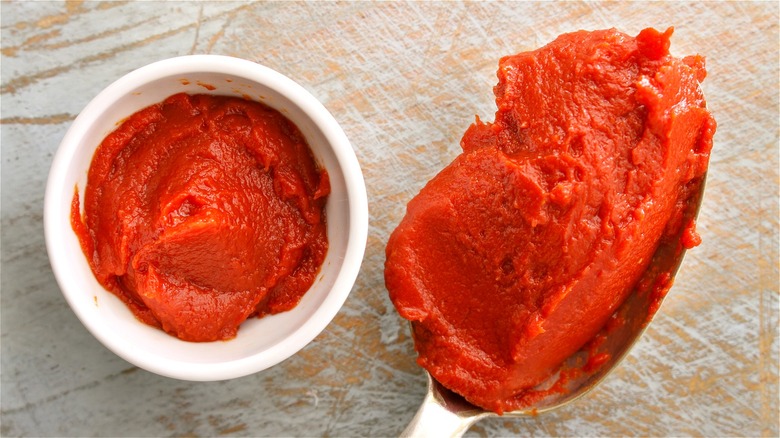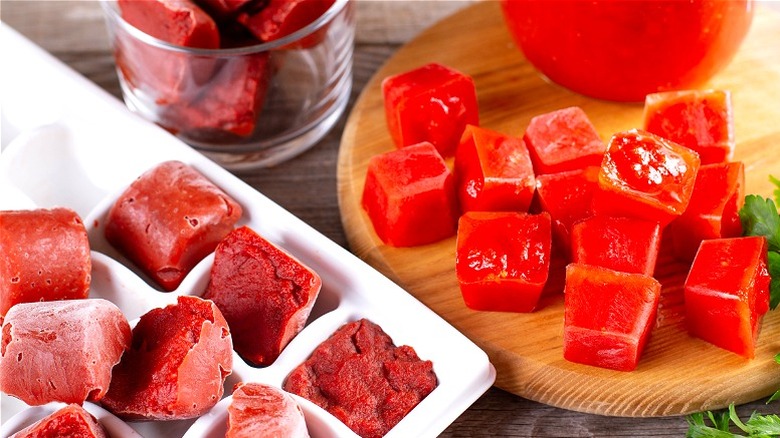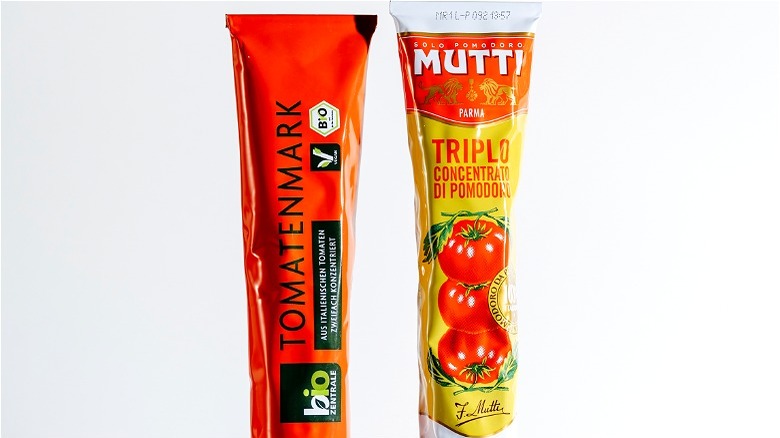The Absolute Best Way To Store Tomato Paste
We may receive a commission on purchases made from links.
Tomato paste has long been one of those reliable pantry staples that inevitably liven the flavor and consistency of your favorite dishes. Sure enough, however, you will run into times when you can't use every last bit that comes packed into each can or tube. You could control how much you use by opting to make your own tomato paste like the recipe outlined by Leite's Culinaria, but after reviewing the number of steps involved, you may choose to continue buying your favorite commercially-sourced brand. What sets tomato paste apart from other available tomato-based products you wonder?
According to MasterClass, tomato paste is different from other tomato products due to its highly concentrated nature. Unlike tomato purée, tomato paste is cooked for a longer period of time to develop that thick, well-rounded consistency. The taste of tomato paste is also sweeter and milder in flavor compared to its diced or strained counterparts. While tomato paste proves to be a handy item to have around when you want to add a thickener or an extra splash of flavor, what's the best way to store tomato paste when you wind up with extra?
Different ways of storing tomato paste
If you're stuck with leftover tomato paste, there are many different ways you to utilize the leftovers. Prevention outlines a few examples such as making your paste into cocktail sauce or a hearty marinade for your favorite cut of meat. Yet, regardless of what you do with the remains of this thick dense paste, it's important to know the proper way to store such an essential pantry staple.
According to the "Rachael Ray Show", storing leftover tomato paste in individual plastic bags in your refrigerator or freezer may be the best method once that six-ounce can have been opened. If you're opting for a glass jar, you can simply screw the lid back on and store the remains in your refrigerator. Interestingly though, if you usually opt for those tubes of tomato paste, the "Rachael Ray Show" describes the importance of squeezing any extra air out from the tube before resealing.
When looking at the differences between the types of paste based on storage, Does It Go Bad? claims tubed tomato paste lasts over a month in your refrigerator when resealed properly. Unfortunately, once the canned paste has been opened, it only has a shelf life of five to seven days when stored correctly, with glass jars lasting up to 10 days. Knowing the storage guidelines for tomato paste, are there other benefits for choosing tubed paste other than its extended shelf life?
The difference between canned and tubed tomato paste
Initially, it may seem like there's no major difference between the varieties of tomato paste considering your initial intentions of using every last teaspoon, no matter which one you choose. You will always need more tomato paste to make another batch of New York-style pizza sauce, right? However, HuffPost points out that transferring any canned remains to plastic bags for your freezer becomes an overlooked task and in the end, you may save more money if you stick with the tubed variety due to its easy-to-store packaging and longer shelf life.
Cook's Illustrated set out to compare these three varieties and get ahold of any notable differences. You may already be aware that tubed tomato paste tends to cost more, but in the long run, will end up saving you more money thanks to convenient packaging. Interestingly though, Cooks Illustrated also determined that most tubed varieties come from Europe, contain more sodium, and are almost always labeled as double or even triple-concentrated. Conversely, canned pastes are made in the U.S. and contain citric acid to be able to stay fresh amidst the somewhat harsh canning process. While both did look and taste slightly different when made into a basic tomato sauce, Cook's Illustrated believes tomato paste in a tube is a better product overall. When it comes to using up all of that precious tomato paste, the tubed variety makes the prospect an easy one.


